Topic: Storms And Severe Weather
Storms And Severe Weather
Which map below shows the most likely storm track for a hurricane (![]() ) in the Atlantic Ocean?
) in the Atlantic Ocean?

(1) 1
(2) 2
(3) 3
(4) 4
Most tornadoes in the Northern Hemisphere are best described as violently rotating columns of air surrounded by
(1) clockwise surface winds moving toward the columns
(2) clockwise surface winds moving away from the columns
(3) counterclockwise surface winds moving toward the columns
(4) counterclockwise surface winds moving away from the columns
In the Northern Hemisphere, surface winds around the center of a hurricane move
(1) clockwise and inward
(2) clockwise and outward
(3) counterclockwise and inward
(4) counterclockwise and outward
Most of the hurricanes that affect the east coast of the United States originally form over the
(1) warm waters of the Atlantic Ocean in summer
(2) warm land of the southeastern United States in summer
(3) cool waters of the Atlantic Ocean in spring
(4) cool land of the southeastern United States in spring
Boarding up windows would be one emergency action most likely taken to prepare for which natural disaster?
(1) earthquake
(2) hurricane
(3) flood
(4) tsunami
The leading edge of a thunderstorm reached Elmira, New York, at 1:00 p.m. This thunderstorm was moving eastward at 45 miles per hour. The leading edge of the thunderstorm most likely reached Binghamton, New York, at approximately
(1) 1:00 p.m.
(2) 2:00 p.m.
(3) 12:00 p.m.
(4) 4:00 p.m.
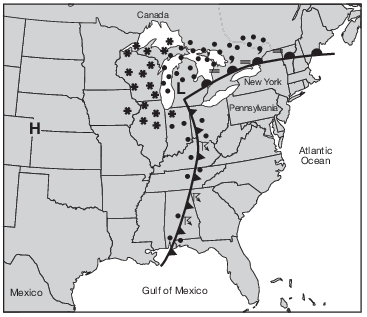
Which weather condition is shown along the cold front?
(1) fog
(2) snow
(3) haze
(4) thunderstorms


State the compass direction in which Hurricane Wilma moved from October 22 through October 25. [1]
Allow 1 credit for NE or northeast or northeastward or for indicating slightly east of northeast.
Hurricane Sandy
In October 2012, Hurricane Sandy produced extreme damage to New York City and the coast of New Jersey due to high winds and a high storm surge. A storm surge is the rise in the level of ocean water along a coast that is caused by strong winds blowing toward land from a severe storm. High ocean tides, occurring at the same time, added to the height of the storm surge. A high-pressure center, located just south of Newfoundland, Canada, affected Hurricane Sandy by altering the path of the jet stream. This change in the jet stream, combined with surface wind circulation around the high-pressure center, caused Hurricane Sandy to curve westward, making landfall along the coast of New Jersey.
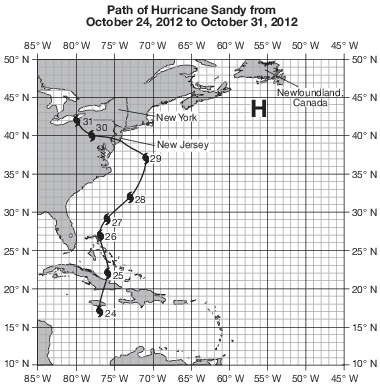
The data table below shows the air pressure, measured in millibars (mb), and surface wind speed, measured in miles per hour (mi/h), recorded near the center of Hurricane Sandy on three separate days.

On the set of axes in the image below, draw a line to represent the general relationship between air pressure and surface wind speed associated with Hurricane Sandy for these three days. [1]
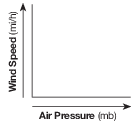
Allow 1 credit for a line showing that, generally, as air pressure increases, wind speed decreases.
• Examples of 1-credit responses:
• 
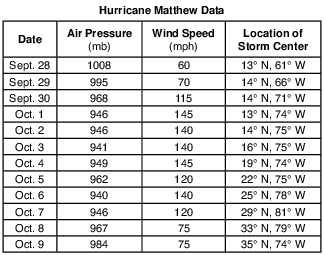
The table below shows the Saffir-Simpson Scale, which is used to classify hurricanes.
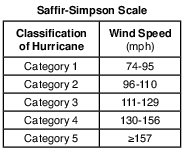
Identify the greatest wind speed of Hurricane Matthew listed on the data table, and identify the classification of Hurricane Matthew based on this wind speed. [1]
Wind speed: ________________________________ mph Classification of hurricane: _________________________________
Allow 1 credit for a wind speed of 145 mph and a Category 4/Cat 4 classification of hurricane.

A tornado watch or warning is issued for a location in the area labeled Tornado Alley. State one safety precaution that should be taken to avoid possible injury from this tornado. [1]
Allow 1 credit. Acceptable responses include, but are not limited to:
• — go to the basement
• — stay away from windows
• — listen to emergency warnings broadcast on radio or TV
• — go to a community emergency shelter
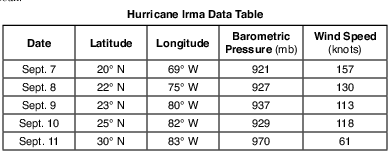
Describe the general relationship between the barometric pressure and wind speed for Hurricane Irma. [1]
Allow 1 credit. Acceptable responses include, but are not limited to:
• — As barometric pressure increases, the wind speed decreases.
• — The higher the wind speed, the lower the pressure.
• — inverse relationship/negative relationship

Describe one ocean surface condition or atmospheric condition that makes the area over the Atlantic Ocean between 10° N latitude and 20° N latitude ideal for these hurricanes to form. [1]
Allow 1 credit. Acceptable responses include, but are not limited to:
• — The warm waters that give the hurricane its energy are located in this tropical region of the
• ocean.
• — Warm ocean waters between 10° N and 20° N fuel hurricanes.
• — Warm and/or humid atmospheric conditions exist between 10° N and 20° N.
• — a maritime tropical air mass
• — low air pressure
• — rising air currents
• — low wind shear
On the map in the image provided, place an X at a location where the tornado damage was greatest. [1]
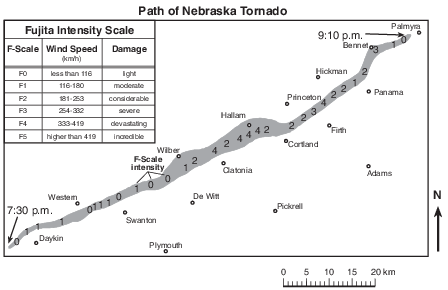
Allow 1 credit if the center of the X is within or touches any of the clear areas along the path of the tornado shown below.
• Note: It is recommended that an overlay of the same scale as the student answer booklet be used
• to ensure reliability in rating.
• 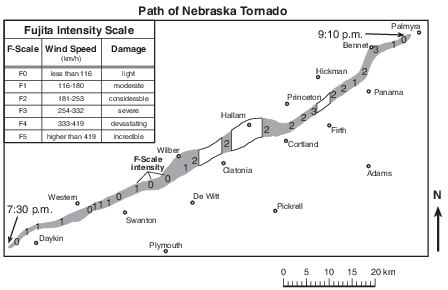

Using the set of axes in the image provided, draw a line to represent the general relationship between barometric pressure and wind speed associated with Hurricane Odile. [1]
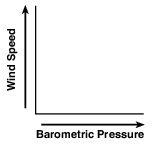
Allow 1 credit for a line that shows a negative slope. Acceptable responses include, but are not limited to:
• Examples of 1-credit responses:
• 
